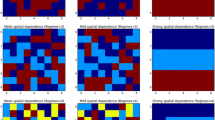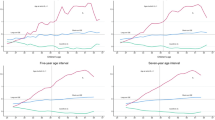Abstract
This article aims to understand mobility within income distribution in cases where there is incomplete information about how individuals transit between income distribution brackets. Understanding these transitions is crucial for evaluating and designing economic policies that affect the population in the long run. For this reason, we propose a methodology that may assist decision-makers to improve policies related to poverty reduction. We start by assuming that the income distribution bracket a person holds exclusively depends on the previous generation’s income bracket, i.e. it has the memoryless property. Therefore, our model resembles a Markov chain model with a steady state distribution that describes the distribution of the income brackets in the long run, and a transition matrix that describes the transitions between income distribution brackets from generation to generation. In contrast to a Markov chain, we assume a given steady state, in order to analyze the space of consistent transition matrices that could generate the steady state proposed. Additionally, we used the joint distribution simulation algorithm developed by Montiel and Bickel (Decis Anal 9:329–347, https://doi.org/10.1287/deca.1120.0252, 2012) to analyze the transition matrix, which allows us to understand the effects of partial information. We test the model with official data from the National Institute of Statistics and Geography and the Social Mobility Survey in Mexico.



Similar content being viewed by others
References
Atkinson AB (1980) On intergenerational income mobility in Britain. J Post Keynesian Econ 3(2):194–218. https://doi.org/10.1080/01603477.1980.11489214
Banerjee AV, Duflo E (2011) Poor economics: a radical rethinking of the way to fight global poverty. Public Affairs, New York
Bartholomew DJ (1967) Stochastic models for social processes. Wiley series in probability and mathematical statistics. Wiley, London
Bleakley H (2010) Malaria eradication in the Americas: a retrospective analysis of childhood exposure. Am Econ J Appl Econ 2(2):1–45. https://doi.org/10.1257/app.2.2.1
CEEY (2011) Encuesta sobre movilidad social (EMOVI). Centro de Estudios Espinosa Yglesias. Tabulados Basicos: https://ceey.org.mx/contenido/que-hacemos/emovi/. Accessed 10 Nov 2021
Cid GM, Montiel LV (2019) Negociaciones de máxima probabilidad para juegos cooperativos con fines comerciales. Revista mexicana de economía y finanzas 14(2):245–259. https://doi.org/10.21919/remef.v14i2.382
INEGI (2016) Encuesta nacional de ingresos y gastos de los hogares. Tabulados Basicos. https://www.inegi.org.mx/programas/enigh/nc/2016/#Tabulados. Accessed 22 June 2021
Jäntti M, Van de gaer D (2019) Multidimensional analysis and mobility: special issue in homage to Tony Atkinson. J Econ Inequal 17:1–4. https://doi.org/10.1007/s10888-019-09410-0
Jæger MM, Blaabæk EH (2021) Local historical context and multigenerational socioeconomic attainment. Res Soc Stratif Mobil 73(100):606. https://doi.org/10.1016/j.rssm.2021.100606
Kanbur R, Stiglitz JE (2016) Dynastic inequality, mobility and equality of opportunity. J Econ Inequal 14(4):419–434. https://doi.org/10.1007/s10888-016-9328-4
Lovasz L (1998) Hit-and-run mixes fast. Math Program 86(3):443–461. https://doi.org/10.1007/s101070050099
Montiel LV (2012) Approximations, simulation, and accuracy of multivariate discrete probability distributions in decision analysis. Ph.d thesis, The University of Texas at Austin, Austin. https://doi.org/10.1007/s11009-012-9292-9
Montiel LV, Bickel EJ (2012) A simulation-based approach to decision making with partial information. Decis Anal 9:329–347. https://doi.org/10.1287/deca.1120.0252
Montiel LV, Bickel JE (2013) Generating a random collection of discrete joint probability distributions subject to partial information. Methodol Comput Appl Probab 15(4):951–967. https://doi.org/10.1007/s11009-012-9292-9
Montiel LV, Bickel EJ (2014) A generalized sampling approach for multilinear utility functions given partial preference information. Decis Anal 11(3):147–170. https://doi.org/10.1287/deca.2014.0296
Neidhöfer G, Stockhausen M (2019) Dynastic inequality compared: multigenerational mobility in the United States, United Kingdom, and Germany. Rev Income Wealth 65(2):383–414. https://doi.org/10.1111/roiw.12364
Shorrocks A (1978) Income inequality and income mobility. J Econ Theory 19(2):376–393. https://doi.org/10.1016/0022-0531(78)90101-1
Smith RL (1984) Efficient Monte Carlo procedures for generating points uniformly distributed over bounded regions. Oper Res 32(6):1296–1308. https://doi.org/10.1287/opre.32.6.1296
Taghizadeh-Hesary F, Yoshino N, Shimizu S (2020) The impact of monetary and tax policy on income inequality in Japan. World Econ 43(10):2600–2621. https://doi.org/10.1111/twec.12782
Acknowledgements
This work was supported by the National Council of Science and Technology of Mexico (CONACYT), and the National System of Researchers (SNI) under Luis V. Montiel Grant: No 259968.
Author information
Authors and Affiliations
Corresponding authors
Additional information
Publisher's Note
Springer Nature remains neutral with regard to jurisdictional claims in published maps and institutional affiliations.
Appendix
Appendix
We derive to its dual form OP (14) from the Lagrangian’s canonical form, where \(\mathbf { \alpha }, \mathbf { \mu } \ge 0\).
Deriving with respect to \(d_{ij}\) we get Eq. (21). Where \(B^c_{ij}\) and \(C^c_{ij}\) are the columns of matrices B and C indexed by i, j.
Defining \(\varphi _{{i,j}} = - 1 - \overrightarrow {\lambda } B_{{ij}}^{c} - \overrightarrow {\beta } C_{{ij}}^{c} + \alpha _{{ij}} - \mu _{{ij}}\), and substituting Eqs. (23) in (20) we get:
Reducing terms we get:
Substituting Eq. (23) and reducing terms we get:
Where the vector a is the vectorized version of matrix A. Assuming A is a transition matrix, which rows sum to one, we have \(Ca={{\textbf {1}}}\), and \(\overrightarrow {\lambda } Ca = \overrightarrow {\lambda } {\mathbf{1}}\). Additionally, we have \(\overrightarrow {\lambda } (Ba + b) = \overrightarrow {\lambda } (\pi A + \pi (I - A)) = \overrightarrow {\lambda } \pi\), where I is the identity matrix. Substituting we get:
From Eq. (27) we can formulate the dual problem as:
Rights and permissions
Springer Nature or its licensor (e.g. a society or other partner) holds exclusive rights to this article under a publishing agreement with the author(s) or other rightsholder(s); author self-archiving of the accepted manuscript version of this article is solely governed by the terms of such publishing agreement and applicable law.
About this article
Cite this article
Arreola, D., Montiel, L.V. Approximating income inequality dynamics given incomplete information: an upturned Markov chain model. Comput Stat 39, 629–651 (2024). https://doi.org/10.1007/s00180-022-01305-5
Received:
Accepted:
Published:
Issue Date:
DOI: https://doi.org/10.1007/s00180-022-01305-5




